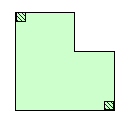Let $C$ be an axis-aligned orthogonal polygon with a finite number of sides. Define an anti-rectangle in $C$ as a set of small squares in $C$, such that no two of them are covered by a single large rectangle in $C$. Define a maximum anti-rectangle as an anti-rectangle that contains a maximum number of squares. For example, the following L-shape has a maximum anti-rectangle with 2 squares:

When I try to build an anti-rectangle, I usually start with putting squares in the corners of $C$, because intuitively, the corners have the least chance of being covered by a rectangle. This raises the following conjecture:
For every $C$, there is a maximum anti-rectangle, which contains a corner square.
(- a corner square is a square with at least two adjacent sides that are in the boundary of $C$).
I found in Chaikan et al (1981) a proof that the conjecture is true when $C$ is linearly-convex (- contains every vertical or horizontal line that connects two of its points; like the L-shape above).
Their proof is not valid when $C$ is not linearly-convex, but I also cannot find a counter-example. What do you say?
